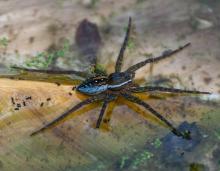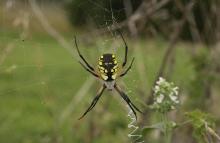Land Invertebrates
Media

Species Types
Scientific Name
Dolomedes triton
Description
The spotted fishing spider lives around ponds, slow-moving streams, swampy areas, and other damp places. It can run across the surface of water much like water striders and will dive for prey, including small tadpoles or aquatic insects.
Media

Species Types
Scientific Name
Leucauge venusta
Description
The orchard orbweaver is a small, colorful, greenish, delicate spider that makes circular webs in low bushes and damp woodlands. It typically hangs in the middle of its web, its back to the ground.
Media

Species Types
Scientific Name
Argiope aurantia
Description
The black-and-yellow garden spider is large but harmless. It sets up large, circular webs in gardens and grasslands. Lucky gardeners can host this remarkable pest exterminator all season long.
Media

Species Types
Scientific Name
Verrucosa arenata
Description
In late summer and fall, woodland hikers can count on walking into the arrowhead spider's web. These webs are delicate circles that help the spider snare tiny flying insects.
Media

Species Types
Scientific Name
Micrathena spp.
Description
Missouri has three species of spiny orbweavers in genus Micrathena. The webs of these woodland spiders are often run into by hikers!
Media

Species Types
Scientific Name
Argiope trifasciata
Description
The banded, or white-backed garden spider is slightly smaller than the black-and-yellow garden spider and has a pointier hind end. The abdomen is patterned with many thin silver and yellow transverse lines and thicker black, spotty lines.
See Also



Media

Species Types
Scientific Name
Cisseps fulvicollis
Description
The yellow-collared scape moth is more often “orange-collared.” And whether you think it looks more like a firefly or a wasp, it’s still a moth!
Media

Species Types
Scientific Name
Nearly 150 species in North America north of Mexico
Description
Slim, delicate plume moths are instantly recognizable by their T-shaped silhouette, long legs, and muted shades of tan and brown. It can be hard to separate the various species.
Media

Species Types
Scientific Name
Pyrrharctia isabella
Description
Not many people know the adult Isabella tiger moth when they see one, but we’re all acquainted with its caterpillar, the woolly worm, or woolly bear.
About Land Invertebrates in Missouri
Invertebrates are animals without backbones, including earthworms, slugs, snails, and arthropods. Arthropods—invertebrates with “jointed legs” — are a group of invertebrates that includes crayfish, shrimp, millipedes, centipedes, mites, spiders, and insects. There may be as many as 10 million species of insects alive on earth today, and they probably constitute more than 90 percent all animal species.





















